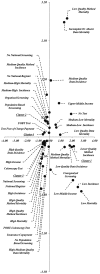Differences in colorectal cancer surveillance epidemiology and screening in the WHO European Region
- PMID: 30675315
- PMCID: PMC6341797
- DOI: 10.3892/ol.2018.9851
Differences in colorectal cancer surveillance epidemiology and screening in the WHO European Region
Abstract
The aim of this study was to describe the Colorectal Cancer (CRC) burden and prevention actions in 53 countries of the World Health Organization (WHO) European Region (ER). Multiple correspondence analysis was applied to examine the association among the following variables: Measures of occurrence; type of screening programme; existence of cancer registries; data quality and; and gross national income (GNI) level. The study demonstrated clear differences according to GNI: low-middle income (LMI) countries show low mortality rates and unorganized screening programme; upper-middle income (UMI) countries show no test offered, incomplete or absent data mortality, and low quality of the method used to estimate incidence and mortality rates; high income (HI) countries show high mortality rates, test offered (FOBT and colonoscopy), the existence of a national registry, screening population-based, insurance of payment policy, and high quality of the method used to estimate incidence and mortality rates. HI countries reflect a strong interest in epidemiological monitoring and produce accurate indicators of disease occurrence. On the other hand, surveillance strategies need to be improved in UMI and LMI countries: As national vital statistics are unavailable, partial or inaccurate, the coverage and completeness of the mortality data are frequently poor, there is a less efficient general organization. In conclusion, it is important to underline that the resources available (as measured by GNI) appear to be major factors in the Colorectal Cancer Surveillance Epidemiology and Screening in the WHO European Region.
Keywords: World Health Organization European Region; colorectal cancer; correspondence analysis; income level; prevention/screening programmes.
Figures
Similar articles
-
HPV-vaccination and cancer cervical screening in 53 WHO European Countries: An update on prevention programs according to income level.Cancer Med. 2019 May;8(5):2524-2534. doi: 10.1002/cam4.2048. Epub 2019 Apr 16. Cancer Med. 2019. PMID: 30993902 Free PMC article.
-
Fecal occult blood test for colorectal cancer screening: an evidence-based analysis.Ont Health Technol Assess Ser. 2009;9(10):1-40. Epub 2009 Sep 1. Ont Health Technol Assess Ser. 2009. PMID: 23074514 Free PMC article.
-
Colorectal cancer prevention in Central, Eastern European and South Caucasus countries: a review of policy approaches.J Health Organ Manag. 2024 May 28;ahead-of-print(ahead-of-print). doi: 10.1108/JHOM-02-2023-0030. J Health Organ Manag. 2024. PMID: 38796752 Review.
-
Impact of Economic Factor, Percent Vaccination, Healthcare Quality, and Population Density on Coronavirus Disease 2019 (COVID-19) Mortality Rates: A Global Analysis in 2023.Cureus. 2025 Mar 14;17(3):e80582. doi: 10.7759/cureus.80582. eCollection 2025 Mar. Cureus. 2025. PMID: 40230777 Free PMC article.
-
[SENTIERI - Epidemiological Study of Residents in National Priority Contaminated Sites. Sixth Report].Epidemiol Prev. 2023 Jan-Apr;47(1-2 Suppl 1):1-286. doi: 10.19191/EP23.1-2-S1.003. Epidemiol Prev. 2023. PMID: 36825373 Italian.
Cited by
-
Abilities of Pre-Treatment Inflammation Ratios as Classification or Prediction Models for Patients with Colorectal Cancer.Diagnostics (Basel). 2021 Mar 21;11(3):566. doi: 10.3390/diagnostics11030566. Diagnostics (Basel). 2021. PMID: 33801031 Free PMC article.
-
A scoping review on population-centered indicators for cancer care continuum.Front Public Health. 2022 Oct 14;10:912946. doi: 10.3389/fpubh.2022.912946. eCollection 2022. Front Public Health. 2022. PMID: 36311597 Free PMC article.
-
The Effects of the Ukrainian Conflict on Oncological Care: The Latest State of the Art.Healthcare (Basel). 2023 Jan 17;11(3):283. doi: 10.3390/healthcare11030283. Healthcare (Basel). 2023. PMID: 36766858 Free PMC article.
-
Overview of Meta-Analyses: The Impact of Dietary Lifestyle on Stroke Risk.Int J Environ Res Public Health. 2019 Sep 25;16(19):3582. doi: 10.3390/ijerph16193582. Int J Environ Res Public Health. 2019. PMID: 31557825 Free PMC article. Review.
-
Burden of colorectal cancer in China, 1990-2017: Findings from the Global Burden of Disease Study 2017.Chin J Cancer Res. 2019 Jun;31(3):489-498. doi: 10.21147/j.issn.1000-9604.2019.03.11. Chin J Cancer Res. 2019. PMID: 31354218 Free PMC article.
References
-
- Ferlay J, Soerjomataram I, Ervik M, Dikshit R, Eser S, Mathers C, Rebelo M, Parkin DM, Forman D, Bray F. International Agency for Research on Cancer. Lyon, France: 2014. [Mar 23;2018 ]. GLOBOCAN 2012 v1.0, cancer incidence and mortality worldwide: IARC cancer base no. 11.
LinkOut - more resources
Full Text Sources
Research Materials


